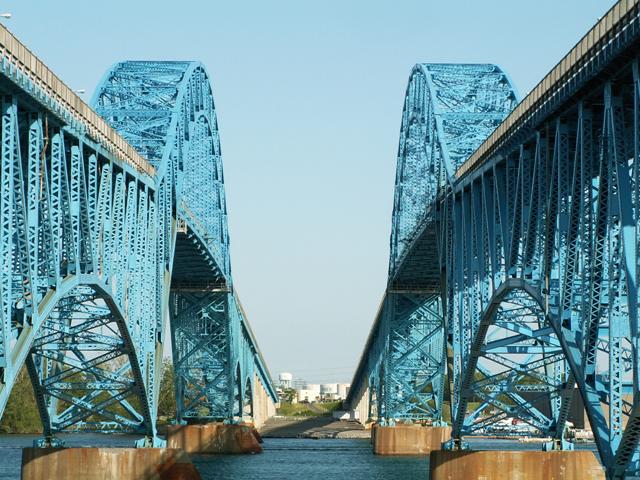We Recommend:
Bach Steel - Experts at historic truss bridge restoration.
South Grand Island Bridges

Primary Photographer(s): Nathan Holth
Bridge Documented: May 28, 2007
Grand Island: Erie County, New York: United States
Metal Cantilever (Arch and Suspended Deck) Rivet-Connected Pratt Through Truss, Fixed and Approach Spans: Metal Cantilever Rivet-Connected Pratt Deck Truss, Fixed
1935 By Builder/Contractor: Taylor-Fichter Steel Construction Company of New York, New York and Engineer/Design: Waddell and Hardesty of New York, New York
1963
400.0 Feet (121.9 Meters)
3,437.2 Feet (1047.7 Meters)
25 Feet (7.62 Meters)
1 Main Span(s) and 32 Approach Span(s)
5043981

View Information About HSR Ratings
Bridge Documentation
Additional Information: Booth and Flynn Company was the substructure contractor for the 1935 bridge. Taylor-Fichter Steel Construction Company was reported as the general contractor in period news articles. In the 1935 AISC Bridge Awards for the north bridge, the fabricators were listed as Fort Pitt Bridge Works, Jones and Laughlin Steel Corporation, and as such it is assumed they were subcontractors, and highlighted in the AISC award as that award focuses on steel construction. It is assumed these same fabricators worked on the southern 1935 bridge as well since the prime contractor, Taylor-Fichter Steel Construction Company, won the award for both the north and south bridges.
Booth and Flynn Company was the substructure contractor for the 1935 bridge.
View Archived National Bridge Inventory Report - Has Additional Details and Evaluation
These two magnificent bridges are stunning landmarks that are among the most beautiful landmark bridges in New York. Steel arch bridges are in general an uncommon structure type, and these two bridges are noteworthy for their monumental size.
At first glance, these might appear to be two identical bridges that were built at the same time. They both have the appearance of 1930s bridges. However, the 1963 northbound bridge is nearly 30 years newer than the 1935 southbound span. It would appear that a very dedicated attempt was made to maintain the aesthetic appearance of the crossing, when the second bridge was added, by making the new bridge look identical to the old one. The attention to detail was quite remarkable, and the northbound bridge has the exact same span configuration as the old one. The lengths of the bridges are listed in the National Bridge Inventory as being identical. Also, by 1963, the use of built-up steel beams was quickly fading, and so the appearance of built-up members containing v-lacing and lattice on the 1963 bridge suggests that this was an intentional decision to make it blend in with the 1935 bridge. Most 1963 bridges would not feature v-lacing and lattice on so many members.
There are some tiny differences that can be found between the two bridge if one bothers to look closely at the structures. The piers supporting the spans that are in the water for the 1935 bridge feature stone cutwaters, while the 1963 bridge does not. Sway bracing on the 1935 span is v-laced, while the sway bracing on the 1963 span is latticed. V-lacing on many of the members of the 1963 span features "railroad style" v-lacing, which was a heavier design that riveted each bar that formed the v-lacing separately of the other. The 1935 bridge in contrast features the more standard v-lacing which used one rivet to attach two v-lacing bars to each side of the beam.
Certainly, the 1935 bridge is more historically significant. It is older, and its design fits in the context of the period. The 1963 bridge is however also noteworthy, and is interesting because it is a 1963 bridge built using the 1930s design and methods. Together they form a beautiful landmark that should be a stop for any traveler in the Niagara area. These bridges can be easily viewed and photographed from Grand Island. They produce beautiful afternoon and evening photos from the island.
![]()
Photo Galleries and Videos: South Grand Island Bridges
Bridge Photo-Documentation
A collection of overview and detail photos. This photo gallery contains a combination of Original Size photos and Mobile Optimized photos in a touch-friendly popup viewer.Alternatively, Browse Without Using Viewer
![]()
Maps and Links: South Grand Island Bridges
Coordinates (Latitude, Longitude):
Search For Additional Bridge Listings:
Bridgehunter.com: View listed bridges within 0.5 miles (0.8 kilometers) of this bridge.
Bridgehunter.com: View listed bridges within 10 miles (16 kilometers) of this bridge.
Additional Maps:
Google Streetview (If Available)
GeoHack (Additional Links and Coordinates)
Apple Maps (Via DuckDuckGo Search)
Apple Maps (Apple devices only)
Android: Open Location In Your Map or GPS App
Flickr Gallery (Find Nearby Photos)
Wikimedia Commons (Find Nearby Photos)
Directions Via Sygic For Android
Directions Via Sygic For iOS and Android Dolphin Browser
USGS National Map (United States Only)
Historical USGS Topo Maps (United States Only)
Historic Aerials (United States Only)
CalTopo Maps (United States Only)

